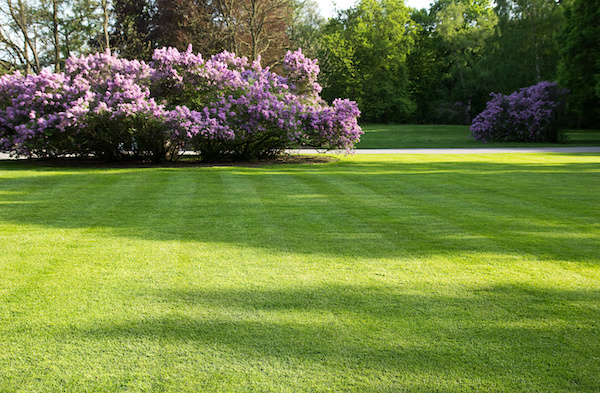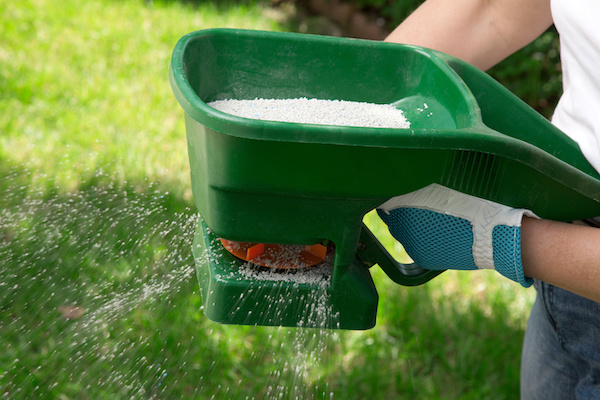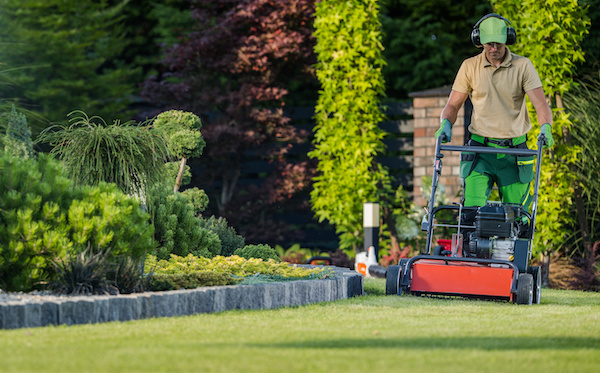Is a lush, healthy, and vibrant lawn your dream? Achieving that dream is easier than you might think. This detailed annual yard maintenance schedule will guide you to keep your lawn looking its best throughout the year. Whether you choose to handle this yourself or hire a lawn care company to take care of it for you, let’s break down our lawn care schedule we recommend for all homeowners.
Short Summary
- Create a tailored lawn care schedule based on the type of grass and local climate for year-round health & beauty.
- Focus on weed/pest control in the spring, regular mowing/watering in summer, aeration/dethatching in fall, and dormant lawn care over winter to prepare for spring.
- Lawn care is all about consistency so it’s important to commit to a schedule or consider hiring lawn care professionals.
Table of Contents
Annual Lawn Care Overview
Before you begin your lawn care journey, it’s crucial to understand the factors that influence the health and beauty of your lawn. The type of grass and local climate play a significant role in determining the best maintenance practices. By tailoring your lawn care routine to the needs of your grass and climate, you’ll be better equipped to address any challenges that may arise.
In this overview, we’ll discuss the differences between warm season and cool season grasses and how climate and weather considerations affect lawn care. With this foundational knowledge, you’ll be prepared to create a lawn care schedule that ensures a healthy and beautiful lawn year-round.
Warm Season vs Cool Season Grasses
Grass types are divided into two categories: warm season and cool season grasses. Warm season grasses, such as Bermuda grass, thrive in hot weather and require increased water and fertilizer applications during the summer months. Cool season grasses, like Kentucky bluegrass, flourish in cooler temperatures and demand more water and fertilizer during the spring and fall seasons.
Understanding the needs of your specific grass type is crucial in providing the appropriate care. This ensures that your lawn stays lush and healthy, and weeds are effectively managed. By catering to the unique requirements of your grass, you’ll be one step closer to a picture-perfect lawn.

Climate and Weather Considerations
Climate and weather conditions have a significant impact on your lawn care routine. Factors such as temperature, rainfall, and humidity affect the frequency and timing of watering and treatment schedule adjustments. For instance, during dry weather, you may need to increase the frequency of watering to keep your lawn healthy.
Pests, like grubs and chinch bugs, can also pose a threat to your lawn’s health. Regular inspections and treatments, as well as exercising caution while applying chemicals, can help prevent and control pest infestations.
By considering climate and weather factors, you can create a more effective lawn care schedule and maintain a healthy, vibrant lawn.
Spring Lawn Care Schedule
Spring is the season of renewal, and your lawn is no exception. After winter dormancy, your grass is eager to grow and thrive, making spring the perfect time to jumpstart your lawn care schedule. In this section, we’ll discuss the importance of preparing your lawn mower, seeding and fertilizing, and weed and pest control during the spring months.
By giving your lawn the attention it needs during spring, you’ll set the stage for a healthy and beautiful lawn throughout the warmer months. By following our spring yard maintenance tips, your lawn will be well on its way to being the envy of the neighborhood.
Preparing Your Lawn Mower
A well-maintained lawn mower is essential for keeping your lawn healthy and attractive. Before the grass starts growing rapidly, take the time to prepare your mower for the season. This includes stabilizing the fuel, cleaning the mower top and bottom, replacing the engine oil, inspecting and replacing blades, and removing gasoline prior to winter storage.
By ensuring your mower is in top-notch condition, you’ll be able to give your lawn the precise and consistent cuts it needs to thrive. A properly maintained lawn mower will also make your lawn care routine more efficient and enjoyable, allowing you to achieve stunning results with ease.

Seeding and Fertilizing
Spring is the ideal time to seed and fertilize your lawn, as it helps your grass recover from winter damage and promotes healthy growth. When seeding, be sure to follow the instructions on the product label, as improper seeding can result in weak or patchy grass growth.
After seeding, it’s essential to water the lawn regularly and keep it free of weeds. Fertilizing your lawn during the spring growing season provides the nutrients it needs to grow strong and healthy. Be sure to choose the right fertilizer for your grass type and follow the recommended application rates and methods to ensure its efficacy and safety.
Weed and Pest Control
A healthy lawn is more resistant to weeds and pests, so spring is the perfect time to tackle these issues head-on. Effective weed control strategies include using pre-emergent herbicides in the spring to prevent weed germination and post-emergent herbicides to target existing weeds.
Pest control is also essential during the spring months to protect your lawn from damage caused by insects like grubs and chinch bugs. Regular inspections and treatments, along with judicious application of insecticides according to label instructions, can help you effectively manage pests and maintain a healthy, beautiful lawn.

Summer Lawn Care Schedule
As the temperatures rise and the days grow longer, your lawn will require a different set of care practices to thrive during the summer months. In this section, we’ll discuss the importance of mowing and watering, fertilization, and pest control during the hot summer season.
By following our summer yard maintenance tips, you’ll be able to keep your lawn looking its best, even in the face of scorching summer heat. Let’s dive into the essential tasks that will keep your lawn healthy and lush throughout the summer months.
Mowing and Watering
During the summer, it is important to mow and water your lawn regularly. This will help keep it healthy. To promote healthy growth, it’s important not to remove more than one-third of the grass blade at a time when mowing. Sharpening your mower blades and varying your mowing patterns can also help keep your lawn in optimal condition.
Watering your lawn deeply and infrequently is key to promoting strong root growth during the summer months. It’s recommended to provide approximately 1 inch of water per week to most lawns, with the best time to water being the early morning.
By adhering to these mowing and watering best practices, your lawn will be more resilient and better equipped to handle the summer heat.
Fertilization and Pest Control
Fertilization is an essential component of lawn care during the summer months, providing your grass with the nutrients it needs to remain healthy and vibrant. Be sure to choose the right fertilizer for your grass type and follow the recommended application rates and methods for optimal results.
Pest control is also vital during the summer, as insects like grubs, chinch bugs, and armyworms can cause significant damage to your lawn. Regular inspections and treatments, along with careful application of insecticides according to label instructions, can help you effectively manage pests and maintain a healthy, beautiful lawn throughout the season.
Fall Lawn Maintenance
As the days grow cooler and the leaves begin to fall, it’s time to shift your focus to fall yard maintenance. In this section, we’ll discuss the importance of aeration and dethatching, overseeding and fertilizing, leaf removal and winter preparation.
By giving your lawn the attention it needs during the fall, you’ll set the stage for a healthy and beautiful lawn throughout the colder months. Let’s explore the essential tasks that will keep your lawn in top shape during the fall season.
Aeration and Dethatching
Aeration and dethatching are essential practices for keeping your lawn healthy and vibrant during the fall season. Aeration involves extracting small plugs of soil from the lawn to decrease soil compaction and enhance air and water circulation. Dethatching involves removing any superfluous material from the soil.
These processes are most effective when conducted in the late summer and early fall when the lawn is able to withstand some damage and recover quickly. By aerating and dethatching your lawn during the fall, you’ll create a stronger, healthier, and more resilient lawn that can better withstand the challenges of the upcoming winter months.
Overseeding and Fertilizing
Overseeding and fertilizing during the fall season provide nourishment to cool-season grasses and encourage their healthy growth. When overseeding, be sure to mow your lawn at a higher height to promote healthy growth, especially in the spring. After overseeding, it’s essential to water the lawn regularly and keep it free of weeds.
Fertilizing your lawn during the late summer and early fall months provides the nutrients it needs to grow strong and healthy. Be sure to choose the right fertilizer for your grass type and follow the recommended application rates and methods to ensure its efficacy and safety.
Leaf Removal and Winter Preparation
As the leaves begin to fall, it’s essential to remove them from your lawn to ensure its health and vitality. Effective leaf removal techniques include using a leaf blower/vacuum, raking onto a tarp, and employing a leaf grabber or a rigid leaf rake.
In addition to leaf removal, preparing your lawn for winter involves applying a winterizing fertilizer to help protect your grass from the cold temperatures. By keeping your lawn clean and properly prepared for winter, you’ll set the stage for a healthy and beautiful lawn the following spring.

Winter Yard Maintenance
While your lawn may be dormant during the winter months, there are still important maintenance tasks to be performed. In this section, we’ll discuss the importance of dormant lawn care and planning for the upcoming spring season.
By taking care of your lawn during the winter months, you’ll be better prepared for the warmer seasons ahead. Let’s explore the essential winter yard maintenance tasks that will keep your lawn healthy and ready for spring.
Dormant Lawn Care
Even during its dormant period, your lawn still requires some care to ensure its health and vitality. Proper watering and weed management are essential during the winter months to keep your lawn healthy. It’s recommended to water your dormant lawn at intervals of two to four weeks, applying 1/4 to 1/2 inch of water each time.
Manually pulling weeds or spot-treating with an organic herbicide can help manage weeds in your dormant lawn. By providing your lawn with the necessary care during its dormant period, you’ll ensure it remains healthy and ready to thrive once spring arrives.
Planning for Spring
As winter draws to a close, it’s time to start planning for the upcoming spring season. This includes raking and tidying up the yard, and removing any debris that may have built up during the winter. Fertilizing, weed control, seeding, dethatching, and aerating are all essential components of preparing for spring.
In addition, mowing at a higher height is advised to promote healthy growth, particularly in the spring. By planning ahead and preparing your lawn for the warmer seasons, you’ll set the stage for a healthy and beautiful lawn throughout the year.

Professional Lawn Care Services
If the prospect of managing your lawn care schedule seems daunting, consider enlisting the help of a professional yard maintenance company. In this section, we’ll discuss the importance of choosing the right service provider and the benefits of customized lawn care programs.
By outsourcing your lawn care to a trusted professional, you can ensure that your lawn receives the expert attention it needs to flourish. Let’s explore how professional yard maintenance services can help you achieve the beautiful lawn you’ve always dreamed of.
Choosing the Right Service Provider
Selecting the right service provider is crucial for the health and beauty of your lawn. A reliable service provider will be well-versed in local climate and weather conditions and can provide tailored lawn care programs that meet your individual requirements.
In addition to offering expert guidance and top-quality products for your lawn treatments, professional service providers can save you time and effort, allowing you to focus on enjoying your beautiful lawn. By choosing the right provider, you’ll be investing in the long-term health and vitality of your lawn.
Customized Lawn Care Programs
Customized lawn care programs offer tailored solutions to address your specific lawn issues, ensuring that your lawn can withstand threats from lawn-damaging weeds and insects, combat diseases, and endure unpredictable weather. These programs typically include mowing, fertilizing, weed and pest control, aeration, dethatching, overseeding, and leaf removal.
By opting for a customized lawn care program, you’ll enjoy peace of mind and more time to spend with your family while specialists take care of your lawn.
Getting the Best Results from Your Lawn Care Schedule
Achieving a healthy and beautiful lawn is a year-round endeavor that requires dedication, knowledge, and the right techniques. By understanding the unique needs of your grass type and climate, following a comprehensive lawn care schedule, and possibly considering the help of a professional lawn care company, you’ll be well on your way to creating the yard of your dreams. Now, it’s time to roll up your sleeves, embrace the challenge, and bring your lawn to its full potential!
Frequently Asked Questions
How often should I treat my yard?
For best results, lawn treatments should be done at least four times a year to ensure healthy growth and prevent pest infestations. To keep your lawn looking its best, follow a regular schedule of inspections and treatments throughout the growing season.
When should I stop mowing my lawn in Minnesota?
When mowing your lawn in Minnesota, it is best to stop when the temperature drops below 50°F during the day, which usually occurs in late October or early November.
To ensure that your grass is kept at a healthy level and to prevent disease from occurring, consider cutting your lawn one last time before winter arrives.
When should I start fertilizing my lawn?
It is best to start fertilizing your lawn in late spring, just as the grass is beginning to actively grow. Apply a dose of fertilizer during this time, followed by one or two more applications during the growing season.
Should you fertilize or control weeds first?
For a healthy and weed-free lawn, it’s important to tackle weeds first before fertilizing. Fertilizing the lawn before controlling the weeds can provide nutrients to unwanted plants, leading to longer lasting and more persistent infestations. Therefore, weed control should be done before you add fertilizer to your lawn.


